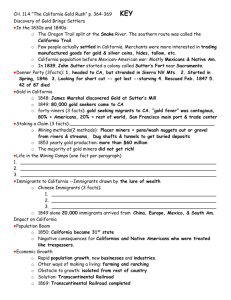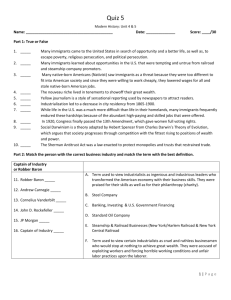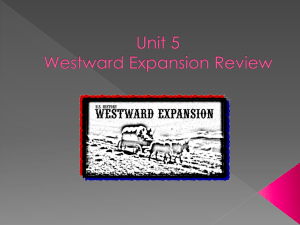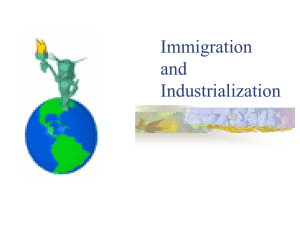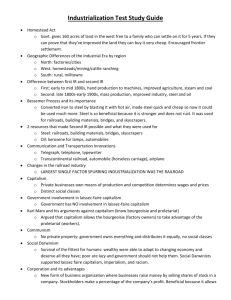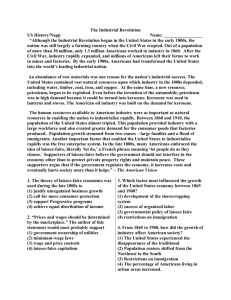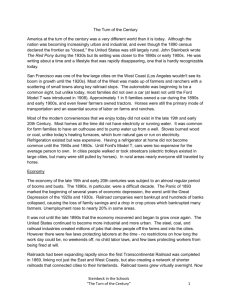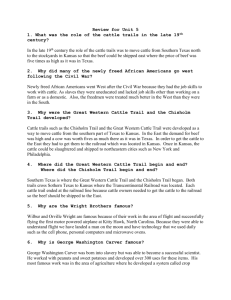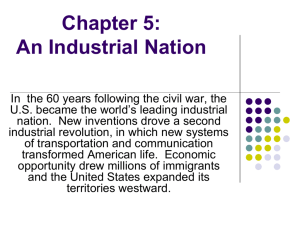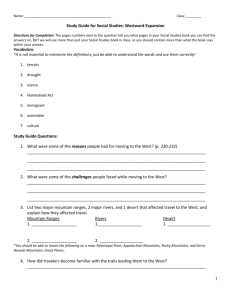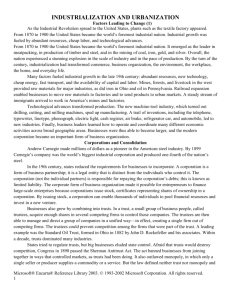20 Westward Expansion, flwg Civil War
advertisement
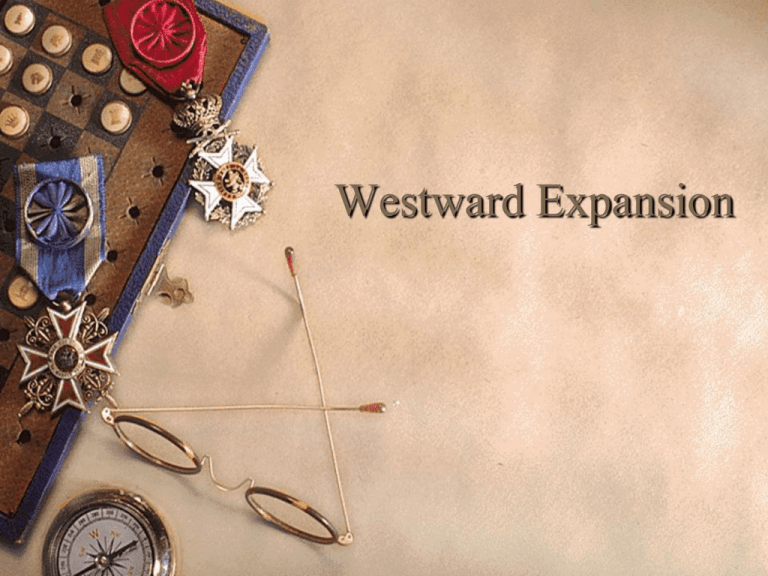
Westward Expansion Factors of American growth and expansion in the late 19th century Westward Movement of population Immigrants flock to America Growth of cities Admission of new states Westward Movement of population Following the Civil War, the westward movement of settlers intensified into the vast region between the Mississippi River and the Pacific Ocean The Way West Transcontinental Railroad Gold Rushes California Gold Rush, 1849 – 100,000 men lured to California – By 1858, all the good mines were taken and they had to look for gold elsewhere Colorado Rush of 1859 – Many of the Californian miners went to Colorado to “strike it rich” – They failed and many returned east, but those who stayed help to build up the population Nevada Rush, 1858 – Comstock Lode was found and $300 million in gold was produced in the next twenty years Black Hills Gold Rush, 1874 – 15,000 miners invaded the Dakota territory Western migration and Gold Effects of the Gold Rush Towns and communities grew in the mining areas With people moving to isolated area, better transportation was needed. Stagecoach lines; pony express (mail from Missouri to California in 10 days) Pony Express Between St. Joseph, MO and Sacramento Ca. Apr 3, 1860 to October 1861 100 stations, 25 miles apart; 80 riders, 400-500 horses Each rider covered 75 miles/day Age of the Cowboy Once the Indians were removed, the land opened up for cattle and cowboys Beef cattle became very profitable Needed to get them from Texas to the northern markets Cattle Drives Began in 1866 from Texas to Missouri Later, railroad extended to Abilene, KS Cattle herded along the Chisholm Trail –4 million head between 1867 and 1879 Immigrants flock to America Prior to 1871, most immigrants to America came from northern and western Europe Germany; Great Britain; Ireland Norway and Sweden Between 1871 and 1921 most came from southern and eastern Europe Italy, Greece, Poland, Russia, and Hungary and Yugoslavia Also, from Asia (China and Japan) Contributions of Immigrants Chinese and Irish workers helped build the Transcontinental Railroad. Others worked in textile and steel mills in the Northeast Clothing industry in New York City Transcontinental Railroad Slavs, Italians, and Poles worked in the coal mines of the East Worked for low pay and dangerous working conditions to help build America’s industrial strength Immigrants flock to America Between 1860 and 1900 almost 14 million immigrants reached the US. Ellis Island was the East Coast processing point for new immigrants The “Melting Pot” They began the process of assimilation into what was termed the American “Melting Pot” Settled in ethnic neighborhoods in the growing cities Worked hard to learn English Adopted American customs Became American citizens Public schools were essential in establishing the melting pot Opposition to Immigration Fear and resentment that immigrants would take jobs for lower pay than Americans Resentment was based on religious and cultural differences Legislation to Limit Immigration Chinese Exclusion Act of 1882 Immigration Restriction Act of 1921 Cut off most immigration to America for the next several decades Growth of cities As the nation’s industrial growth continued many cities grew rapidly: Chicago, Detroit, Cleveland, Pittsburgh, and New York City With the growth of cities came factories, and harsh living conditions in crowded tenements and slums. Also caused housing shortages and the need for new public services: sewage and water systems and public transportation Immigration Push/Pull Factor Push (Reasons to leave) Religious/Political Persecution Agricultural poverty Relaxation of emigration laws Pull (Reasons to Come) Promise of Freedom and hope Family/Friends Network Need for and Recruitment of labor Immigrant Contributions They broadened cultural life of America through – New music – New languages – Diverse religious beliefs – Variety of foods and customs Famous Immigrants Irving Berlin: Composer, wrote “God Bless America” George and Ira Gershwin: composers Enrico Fermi: Scientist Albert Einstein: Scientist Industrial Revolution Between the Civil War and World War I, the US was transformed from a mostly agricultural nation to most urban and industrial nation. Technological revolution changed the way people worked, played, traveled and communicated A new power source and production methods stimulated the expansion of industry Transforming America Technological change spurred the growth of industry primarily in northern cities Inventions/Inventors Light Bulb – Thomas Edison Telephone – Alexander Graham Bell Airplane – Wright Brothers Assembly Line – Henry Ford Bessemer Process – Converted iron ore into steel with less labor Industrial Leaders Andrew Carnegie – Steel industry J. P. Morgan – Railroad and US Steel John D. Rockefeller – Standard Oil Company Cornelius Vanderbilt - Railroad Reasons for Economic Transformation Government policies of laissez-faire capitalism and special considerations such as land grants to railroad builders) Increasing labor supply (immigration and migration from farms America’s possession of a wealth of natural resources and navigable rivers
